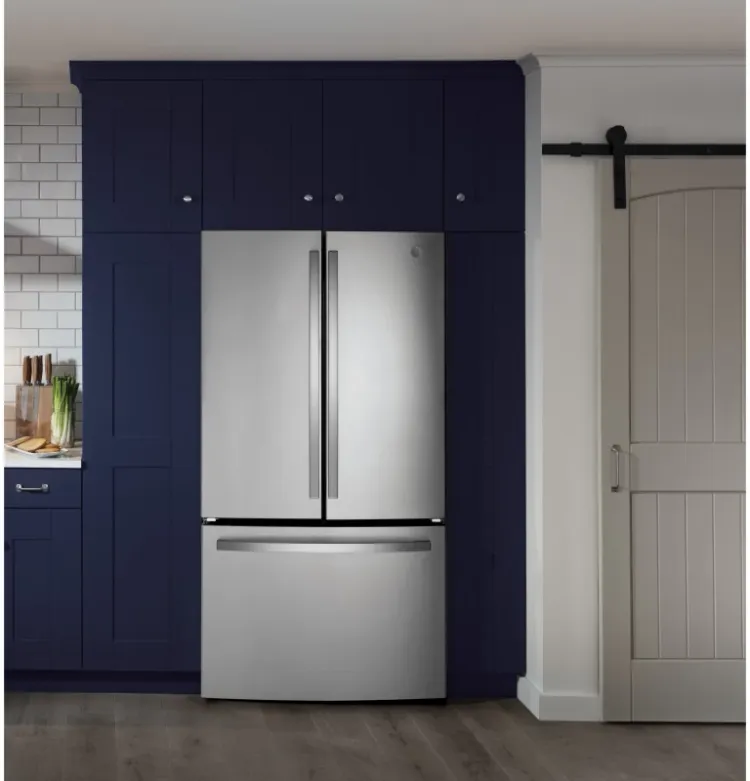Why is My Fridge Making Loud Humming Noises? A Guide To A Common Problem

Is your fridge making loud humming noises that are becoming impossible to ignore? You're not alone. Many homeowners experience this issue and often wonder if it signals a bigger problem. Addressing these noises promptly is crucial for maintaining your refrigerator's efficiency and longevity. Ignoring them could lead to more significant issues down the line, potentially resulting in costly repairs or even the need for a replacement. In this guide, we'll delve into the common causes of a noisy refrigerator, explore simple troubleshooting steps, and help you decide when it's time to call in the professionals.
Common Causes of Loud Humming Noises
Dirty Condenser Coils
Condenser coils are located either at the back or underneath your fridge and play a critical role in dissipating heat. These coils help release the heat generated by the refrigerator’s cooling process.
How Dirt Affects Performance and Causes Noise
Over time, these coils can become clogged with dust, pet hair, and other debris. When the coils are dirty, the refrigerator must work harder to cool down, leading to increased humming noises. The buildup not only reduces efficiency but also puts extra strain on the compressor.
Cleaning Steps
1. Unplug the Refrigerator: Always unplug your fridge before cleaning.
2. Locate the Coils: Find the coils either at the back or underneath the fridge.
3. Use a Coil Brush or Vacuum: Gently clean the coils using a coil brush or vacuum with a brush attachment.
4. Wipe Down with a Damp Cloth: For any stubborn dirt, use a damp cloth to wipe it away.
5. Replug the Fridge: Plug your fridge back in and listen for any improvement in noise levels.
Improper Leveling
Impact of an Unlevel Fridge on Noise and Performance
An improperly leveled fridge can cause various problems, including loud humming noises. If the fridge isn't level, components like the compressor and fan may not function optimally, leading to increased noise and vibration.
How to Level Your Fridge
1. Check the Level: Place a level on top of your fridge to see if it’s even.
2. Adjust the Feet: Most fridges have adjustable feet. Turn them to raise or lower each corner until the fridge is level.
3. Recheck and Fine-Tune: Double-check with the level and make any necessary adjustments.
Faulty or Obstructed Evaporator Fan
Role of the Evaporator Fan
The evaporator fan circulates air over the evaporator coils and throughout the fridge to keep temperatures consistent.
Common Issues and Solutions
- Obstruction: Items inside the fridge might obstruct the fan blades. Ensure the fan area is clear.
- Faulty Fan Motor: If the fan motor is failing, it might produce a loud humming noise. In this case, you may need to replace the motor.
- Ice Build-Up: Sometimes, ice can build up around the fan, causing it to make noise. Defrosting your fridge might solve this problem.
Compressor Issues
Function of the Compressor
The compressor is essential for cooling, as it compresses the refrigerant and circulates it through the fridge’s cooling system.
Signs of a Failing Compressor and Potential Fixes
- Loud Humming or Clicking: A failing compressor might produce loud humming or clicking sounds.
- Overheating: If the compressor feels unusually hot, it might be struggling to function.
- Professional Repair: Diagnosing and fixing compressor issues typically requires a professional. If you suspect a compressor problem, it's best to call a professional fridge repair technician.
Damaged or Worn-Out Fan Blades
Importance of Fan Blades in Cooling
Fan blades help circulate air inside the fridge, ensuring even cooling. Damaged or worn-out blades can cause uneven cooling and noise.
Identifying and Replacing Damaged Blades
- Listen for Noise: If the noise comes from the area where the fan is located, inspect the blades.
- Visual Inspection: Check the blades for cracks, chips, or wear.
- Replacement: If you find any damage, replacing the fan blades is necessary. Refer to your fridge's manual for the correct part and replacement procedure.
Troubleshooting Steps
Listen and Locate the Noise Source
Steps to Pinpoint Where the Noise is Coming From
1. Turn Off Other Appliances: Ensure other appliances and background noises are minimized.
2. Move Close to the Fridge: Get close to the refrigerator and listen carefully.
3. Identify the Area: Determine if the noise is coming from the back, bottom, or inside the fridge.
4. Use a Stethoscope: If available, use a mechanic's stethoscope to precisely locate the noise source.
Inspect and Clean Key Components
How to Check Condenser Coils, Fans, and Other Parts
1. Unplug the Fridge: Always start by unplugging the refrigerator for safety.
2. Inspect Condenser Coils: Look for dust and dirt on the condenser coils and clean them as described in the previous section.
3. Check the Evaporator Fan: Open the freezer compartment and listen for the fan. If it’s making noise, inspect for obstructions or damage.
4. Examine the Compressor: Check for unusual noises or overheating from the compressor.
5. Inspect Fan Blades: Look at both the evaporator and condenser fan blades for any damage or obstructions.
Check for Obstructions
Ensuring Proper Airflow and Ventilation Around the Fridge
1. Clear the Area Around the Fridge: Make sure there is adequate space around the fridge for ventilation (usually at least 2-3 inches on all sides).
2. Inspect Inside the Fridge: Ensure that items inside the fridge are not blocking vents or obstructing the evaporator fan.
3. Check Vents and Airflow Paths: Make sure all internal and external vents are clear and unobstructed.
Level the Refrigerator
Detailed Steps to Level the Appliance Properly
1. Place a Level on Top of the Fridge: Check the level both front-to-back and side-to-side.
2. Adjust the Front Feet: Most refrigerators have adjustable front feet. Turn them clockwise or counterclockwise to raise or lower the fridge until it's level.
3. Adjust the Rear Feet (if applicable): Some models also have rear feet that can be adjusted in the same manner.
4. Recheck the Level: After adjustments, recheck with the level and make any fine-tuning as necessary.
5. Test the Door Swing: Ensure that the fridge doors close properly and don’t swing open. Adjust if needed.
DIY Fixes
Cleaning Condenser Coils
One of the simplest yet most effective DIY fixes for a noisy fridge is cleaning the condenser coils. Over time, these coils collect dust and debris, which can hinder their performance and cause your fridge to make loud humming noises.
- Step-by-Step Guide:
1. Unplug the Fridge: Always start by unplugging your refrigerator to ensure safety.
2. Locate the Coils: The condenser coils are usually located at the back of the fridge or underneath it. Refer to your fridge’s manual if you’re unsure.
3. Access the Coils: If the coils are at the back, you may need to pull the fridge away from the wall. For coils underneath, remove the front grille.
4. Clean the Coils: Use a soft brush or a vacuum cleaner with a brush attachment to gently remove dust and debris from the coils. Be thorough but gentle to avoid damaging the coils.
5. Regular Maintenance: Repeat this cleaning process every six months to keep your fridge running efficiently and quietly.
Defrosting the Evaporator Fan
The evaporator fan circulates cool air throughout the fridge and freezer. If this fan gets blocked by ice, it can cause a loud humming noise. Defrosting and cleaning the fan can resolve this issue.
How to Thaw and Clean the Fan:
1. Unplug the Fridge: Ensure the fridge is unplugged before starting any work.
2. Remove Shelves and Food: Take out any shelves or food items blocking access to the fan, usually located in the freezer compartment.
3. Locate the Fan: The fan is typically behind a panel. Unscrew and remove this panel to access the fan.
4. Thaw Ice Buildup: Use a hairdryer to gently thaw any ice buildup around the fan blades. Be cautious not to overheat any components.
5. Clean and Reassemble: Wipe away any moisture with a towel. Ensure the fan blades spin freely before reassembling the panel and replacing the shelves and food.
Replacing Faulty Parts
Identifying and replacing faulty parts can significantly reduce noise. Common parts that may need replacing include fan motors and blades, and sometimes the compressor.
- Identifying Parts That May Need Replacement:
- Evaporator and Condenser Fan Motors: If the fan motors are noisy or not working, they may need replacement.
- Fan Blades: Damaged or bent blades can cause noise and should be replaced.
- Compressor: A faulty compressor is often noisy and requires professional replacement.
- Basic Guide on How to Replace Them:
1. Fan Motors and Blades:
- Unplug the Fridge: Ensure safety by disconnecting power.
- Access the Fan: Remove panels to expose the fan.
- Disconnect and Remove: Unplug the motor and remove mounting screws to take out the faulty motor or blades.
- Install New Parts: Secure the new motor or blades in place, reconnect wires, and reassemble the panels.
2. Compressor:
- Professional Help: Due to the complexity and need for specialized tools, replacing a compressor should be done by a certified technician.
Lubricating Moving Parts
Lubricating the moving parts of your fridge can reduce noise caused by friction and keep the appliance running smoothly.
Importance and Method of Lubrication:
1. Identify Moving Parts: Key parts to lubricate include fan motors and hinges.
2. Choose the Right Lubricant: Use a silicone-based lubricant as it is safe for plastic and metal parts.
3. Apply Lubricant:
- Fan Motors: Apply a small amount of lubricant to the motor shafts.
- Hinges: Lubricate door hinges to ensure smooth operation.
4. Avoid Over-Lubrication: Too much lubricant can attract dust and cause other issues. Apply sparingly and wipe away any excess.
By following these detailed DIY fixes, you can address many common causes of loud humming noises in your fridge. Regular maintenance and timely repairs can help keep your refrigerator running quietly and efficiently, saving you from potential headaches and costly repairs down the line.
When to Call a Professional
While DIY fixes can resolve many common issues with your fridge, there are times when professional help is necessary. Knowing when to call a technician can save you from further damage and potential safety hazards.
Signs That Indicate the Need for Professional Help
Persistent Noise Despite Troubleshooting
If you've cleaned the condenser coils, leveled the fridge, and checked the fans but the noise persists, it may indicate a more serious underlying issue.
Refrigerator Not Cooling Properly
A fridge that is noisy and also failing to maintain the correct temperature can be a sign of compressor failure or other significant problems that require a professional diagnosis and repair. If you're fridge is not cooling, make sure to get repairs done as soon as possible.
Frequent Cycling On and Off
If your fridge cycles on and off more frequently than usual and is accompanied by loud noises, it could indicate a failing compressor or other mechanical issues that need expert attention.
Electrical Issues
Any signs of electrical problems, such as flickering lights inside the fridge, should be addressed by a professional. Electrical repairs can be dangerous and should not be attempted without proper knowledge and tools.
Complex Part Replacements
Replacing complex components like the compressor or dealing with refrigerant lines should always be handled by a certified technician. These repairs require specialized tools and expertise.
Unusual Smells or Leaks
If you notice burning smells or refrigerant leaks (often a chemical smell), turn off the appliance and call a professional immediately. These can be serious issues that pose health and safety risks.
Addressing loud humming noises in your fridge involves understanding the common causes, such as dirty condenser coils, improper leveling, faulty evaporator fans, compressor issues, and damaged fan blades. Follow detailed troubleshooting steps like listening to locate the noise source, inspecting and cleaning key components, checking for obstructions, and ensuring your refrigerator is level, you can often resolve these issues yourself.
Regular maintenance is key to ensuring refrigerators runs efficiently. By keeping up with cleaning and inspections, you can extend the lifespan of your appliance and avoid costly repairs. If problems persist, finding a reliable technician with good reviews, proper certification, and clear communication can provide the necessary expertise to keep your fridge in top condition.
By following these guidelines, you can enjoy a quieter, more efficient refrigerator, making your home environment more comfortable and ensuring the longevity of your appliance.



